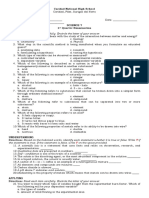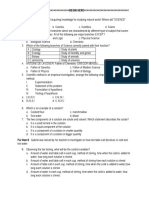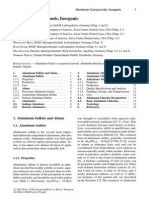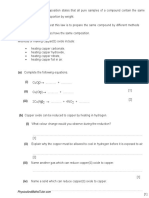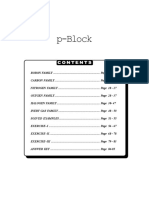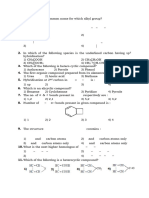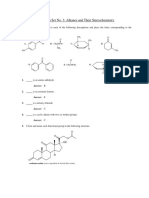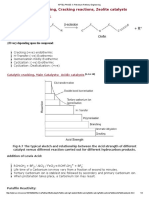Worksheet 1
Uploaded by
Keril MasonWorksheet 1
Uploaded by
Keril MasonAndinet
International
SCIENCE
EXPLORING
WORKING SCIENTIFICALLY
7 3rd Term Worksheet 1
Name ____________________________________ Date ______________
Year 7 Section _______ Subject:- Science
Give short, precise and the correct answer for the following questions. Circle letter of the
correct answer for multiple questions.
1. Acids taste:
A. fishy. B. salty C. sour. D. sweet.
2. The name of an acid in lemon juice is:
A. citric acid. B. ethanoic acid. C. lemonic acid. D. sulfuric acid.
3. You can prevent acids from splashing into your eyes by wearing:
A. an overall. B. gloves. C. long hair tied back. D. safety spectacles.
4. Which one of these is an acid?
A. oven cleaner B. salt water C. pure water D. vinegar
5. Which one of these is an alkali?
A. lemon juice B. oven cleaner C. sugar solution D. vinegar
6. Red cabbage can be used as an indicator because it:
A. changes colour. C. comes from a plant.
B. is an acid. D. is an alkali.
7. The colour of litmus in sulfuric acid is:
A. blue. B. green. C. purple. D. red.
8. The pH of pure water is: A. 1 B. 5 C. 7 D. 11
9. The colour of universal indicator in a substance that is very acidic is:
A. green. B. orange. C. purple. D. red.
10. The pH of a substance that is slightly alkaline could be:
© Pearson Education Ltd.
1|P a g e
AIS P.O. Box 1287 Addis Ababa, Ethiopia Phone: +251-11-647 99 97 E-mail: ais@ethionet.et
Teacher(s): Mr. Eshetu E & Mr. Wondwossen D Web: www.andinetinternationalschool.edu.et
A. 1 B. 5 C. 9 D. 13
11. Universal indicator is added to a solution. The solution turns purple. The solution contains:
A. citric acid. C. hydrochloric acid.
B. sodium hydroxide solution. D. only water.
12. The reaction between an acid and an alkali is:
A. acidification. C. condensation.
B. evaporation. D. neutralisation.
13. A solution of pH 3 was mixed with a solution of pH 9. The final pH could be:
A. 2 B. 6 C. 10 D. 12
14. An acid reacted with an alkali to form a salt and water. Which of these are the reactants?
A. acid and alkali C. acid and salt
B. alkali and water D. salt and water
15. Nitric acid reacts with sodium hydroxide solution to form a salt and water. Which of the following is
the correct word equation?
A. nitric acid + sodium hydroxide salt + water
B. nitric acid + sodium hydroxide → sodium nitrate + water
C. salt + water → nitric acid + sodium hydroxide
D. sodium nitrate + water → nitric acid + sodium hydroxide
16. Indigestion tablets often contain:
A. acids. B. antacids. C. antibiotics. D. indicators.
17.Which of the following will react with zinc oxide to form zinc chloride?
A. sulfuric acid B. nitric acid C. hydrochloric acid D. sodium chloride
18. A certain rust remover contains sulfuric acid. The salt formed when sulfuric acid reacts with iron oxide
(rust) is:
A. iron chloride. B. iron hydroxide. C. iron nitrate. D. iron sulfate.
19.Answer the following questions choosing one of the substances from the box below.
Lemon juice oven cleaner pure water salt water sugar
a. Name a substance containing an acid. ____________________________
b. Name a substance containing an alkali. ___________________________
© Pearson Education Ltd.
2|P a g e
AIS P.O. Box 1287 Addis Ababa, Ethiopia Phone: +251-11-647 99 97 E-mail: ais@ethionet.et
Teacher(s): Mr. Eshetu E & Mr. Wondwossen D Web: www.andinetinternationalschool.edu.et
20.State the meaning of each hazard symbol below.
a. c.
b. d.
of Unit Test Stan
21. (a) What is the colour of litmus in an acid solution? Tick one box.
A. Red B. green C. blue D. purple
(b) What is the colour of litmus in an alkali solution? Tick one box.
A. Red B. green C. blue D. purple
22.An indicator called methyl orange is pink in an acid, yellow in an alkali and orange in a neutral
solution.
State the colour of methyl orange in each of the following solutions:
a. sodium hydroxide ___________________________________
b. salt water __________________________________________
c. vinegar ____________________________________________
23.A student wants to investigate the pH changes when an acid
reacts with an alkali. He puts 5 cm3 of the acid in a tube. He
adds the alkali 1 cm3 at a time. Each time he adds 1 cm3 alkali,
he measures the pH of the solution. His results are shown on
the graph.
© Pearson Education Ltd.
3|P a g e
AIS P.O. Box 1287 Addis Ababa, Ethiopia Phone: +251-11-647 99 97 E-mail: ais@ethionet.et
Teacher(s): Mr. Eshetu E & Mr. Wondwossen D Web: www.andinetinternationalschool.edu.et
a. Suggest how the student could measure the pH of the solution.
_______________________________
b. Which volume of alkali is added to make the solution neutral? Tick one box.
A. 1 cm3 B. 3 cm3 C. 5 cm3 D. 7 cm3
b. Explain what the graph shows.
___________
24.Explain why some farmers put a chemical called lime on the soil before planting their crops.
___________________________________________________________________________________
________________________________________________________________________________
25. A student investigates the temperature rise when different acids react with sodium hydroxide
solution. She measures 10 cm3 of sodium hydroxide solution and records the temperature. She adds 10
cm3 of an acid to the sodium hydroxide solution and records the new temperature. She calculates the
temperature rise. She repeats the experiment with the same volume of the sodium hydroxide solution
but adds different types of acid. Her results are in the table.
Types of acid added to sodium hydroxide solution Temperature rise (0C)
Citric acid 3.5
Hydrochloric acid 13.6
Nitric acid 13.6
Vinegar (Ethanoic acid) 6.8
a. State what has been kept the same in this experiment to make the test fair.
________________________________________________________________________
b. Which variable has been changed in this experiment (the independent variable)? Tick one box.
A. the volume of acid C. the type of acid
B. the volume of alkali D. the temperature rise
c. Which variable has been measured (the dependent variable)? Tick one box.
A. the volume of acid C. the type of acid
B. the volume of alkali D. the temperature rise
d. What is the name of the reaction between an acid and an alkali? Tick one box.
A. Oxidation C. reduction
B. neutralisation D. decomposition
© Pearson Education Ltd.
4|P a g e
AIS P.O. Box 1287 Addis Ababa, Ethiopia Phone: +251-11-647 99 97 E-mail: ais@ethionet.et
Teacher(s): Mr. Eshetu E & Mr. Wondwossen D Web: www.andinetinternationalschool.edu.et
26.The word equation for a reaction is:
hydrochloric acid + sodium hydroxide → sodium chloride + water
a. State the names of the two reactants in the word equation.
____________________________________________________________________
b. State the name of one salt in the word equation.
____________________________________________________________________
27.(a) Sulfuric acid reacts with magnesium oxide to make magnesium sulfate and water.
Write the word equation for this reaction.
________________________________________________________________________
(b) Coal-burning power stations produce waste gases that contain sulfuric acid. Describe how the
waste gases are treated to prevent release of sulfuric acid into the air.
__________________________________________________________________________
28. General equations:
acid + alkali → salt + water
acid + base → salt + water
Complete the word equations below for the reactions of acids with alkalis or bases.
Use the names of the chemicals from the box at the bottom of the page. Each chemical may be
used once, more than once or not at all.
1. hydrochloric acid + sodium hydroxide ________________ + water
2. sulfuric acid + magnesium oxide ____________________ + water
3. nitric acid + __________________ zinc nitrate + water
4. ___________________ + potassium hydroxide → potassium chloride + water
5. sulfuric acid + _______________________ calcium sulfate + water
6. _______________________ + sodium hydroxide sodium nitrate + water
calcium oxide hydrochloric acid magnesium sulfate nitric acid
sodium chloride sulfuric acid zinc oxide
© Pearson Education Ltd.
5|P a g e
AIS P.O. Box 1287 Addis Ababa, Ethiopia Phone: +251-11-647 99 97 E-mail: ais@ethionet.et
Teacher(s): Mr. Eshetu E & Mr. Wondwossen D Web: www.andinetinternationalschool.edu.et
You might also like
- ZIMSEC Form 2 End of Term 1 Exam Paper 1 and Paper 2 Questions Combined Science Set 189% (9)ZIMSEC Form 2 End of Term 1 Exam Paper 1 and Paper 2 Questions Combined Science Set 18 pages
- First Periodical Test in Science 7 2022 2023No ratings yetFirst Periodical Test in Science 7 2022 20234 pages
- Grade 7 First Quarter Multiple Choice Exam (With TOS)No ratings yetGrade 7 First Quarter Multiple Choice Exam (With TOS)8 pages
- Science 7: Gov. A. Bernad ST., Poblacion 1, Oroquieta CityNo ratings yetScience 7: Gov. A. Bernad ST., Poblacion 1, Oroquieta City3 pages
- 2nd Periodical Exam Remedial Exam on BiologyNo ratings yet2nd Periodical Exam Remedial Exam on Biology2 pages
- Questions 2 To 4 Are Based On The Figure BelowNo ratings yetQuestions 2 To 4 Are Based On The Figure Below5 pages
- Name ... : Grade 5: Al Andalus International SchoolNo ratings yetName ... : Grade 5: Al Andalus International School16 pages
- Acids, Bases and Salts WKST With Ans. KeyNo ratings yetAcids, Bases and Salts WKST With Ans. Key4 pages
- MCQs From CBSE Class 10 Science Chapter 1No ratings yetMCQs From CBSE Class 10 Science Chapter 159 pages
- Science 7 First Periodic Examination 2022 202350% (2)Science 7 First Periodic Examination 2022 20233 pages
- Second Periodical Exam Chemistry 2011 - 2012No ratings yetSecond Periodical Exam Chemistry 2011 - 201210 pages
- First Periodic Examination in Grade 7 Science S.Y 2016-2017: For Questions 6 and 7No ratings yetFirst Periodic Examination in Grade 7 Science S.Y 2016-2017: For Questions 6 and 77 pages
- Cambridge Global English 2nd WB Answers (S.A.files?)100% (2)Cambridge Global English 2nd WB Answers (S.A.files?)15 pages
- Blue BC Blue CLF Red FBB S4R Brown S3R: BlusbbNo ratings yetBlue BC Blue CLF Red FBB S4R Brown S3R: Blusbb186 pages
- Module4 - Volumetric Method of AnalysisNo ratings yetModule4 - Volumetric Method of Analysis18 pages
- Bioorganic & Medicinal Chemistry LettersNo ratings yetBioorganic & Medicinal Chemistry Letters4 pages
- Learning Target: Describe The General Structure, Subunits, and Examples For Each of The Four TypesNo ratings yetLearning Target: Describe The General Structure, Subunits, and Examples For Each of The Four Types3 pages
- Main Group Chemistry (Group Va) - Part A - DR AkinsikuNo ratings yetMain Group Chemistry (Group Va) - Part A - DR Akinsiku46 pages
- 2408160808143526108hydrogen Chloride 2024No ratings yet2408160808143526108hydrogen Chloride 20247 pages
- Class X Science Last minute revision module (1)No ratings yetClass X Science Last minute revision module (1)38 pages
- Hydrocarbon For JEE Main and Advanced (ALP)100% (1)Hydrocarbon For JEE Main and Advanced (ALP)10 pages
- Cheat Sheet For Organic Chemistry Midterm 1 2015 1No ratings yetCheat Sheet For Organic Chemistry Midterm 1 2015 11 page
- Nptel - Chemical Engineering Petroleum Refinery Engineering16 PDFNo ratings yetNptel - Chemical Engineering Petroleum Refinery Engineering16 PDF4 pages
- ZIMSEC Form 2 End of Term 1 Exam Paper 1 and Paper 2 Questions Combined Science Set 1ZIMSEC Form 2 End of Term 1 Exam Paper 1 and Paper 2 Questions Combined Science Set 1
- Grade 7 First Quarter Multiple Choice Exam (With TOS)Grade 7 First Quarter Multiple Choice Exam (With TOS)
- Science 7: Gov. A. Bernad ST., Poblacion 1, Oroquieta CityScience 7: Gov. A. Bernad ST., Poblacion 1, Oroquieta City
- Name ... : Grade 5: Al Andalus International SchoolName ... : Grade 5: Al Andalus International School
- First Periodic Examination in Grade 7 Science S.Y 2016-2017: For Questions 6 and 7First Periodic Examination in Grade 7 Science S.Y 2016-2017: For Questions 6 and 7
- O Level Biology Practice Questions And Answers Plant NutritionFrom EverandO Level Biology Practice Questions And Answers Plant Nutrition
- Cambridge Global English 2nd WB Answers (S.A.files?)Cambridge Global English 2nd WB Answers (S.A.files?)
- Learning Target: Describe The General Structure, Subunits, and Examples For Each of The Four TypesLearning Target: Describe The General Structure, Subunits, and Examples For Each of The Four Types
- Main Group Chemistry (Group Va) - Part A - DR AkinsikuMain Group Chemistry (Group Va) - Part A - DR Akinsiku
- Cheat Sheet For Organic Chemistry Midterm 1 2015 1Cheat Sheet For Organic Chemistry Midterm 1 2015 1
- Nptel - Chemical Engineering Petroleum Refinery Engineering16 PDFNptel - Chemical Engineering Petroleum Refinery Engineering16 PDF





































